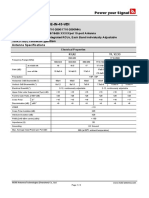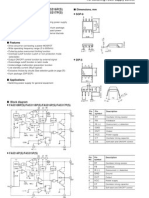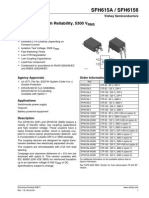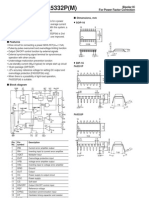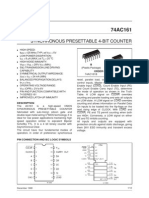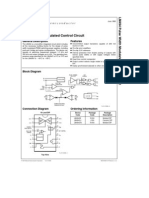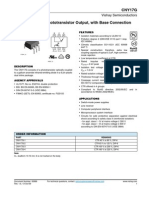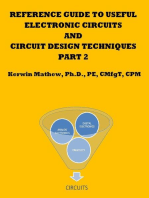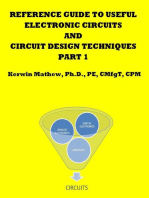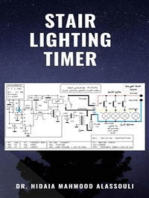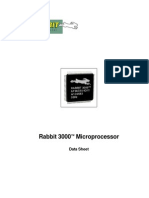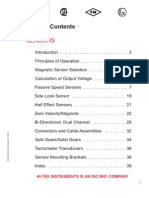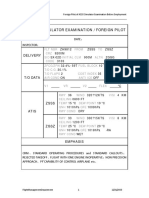MM74HC4046 PDF
MM74HC4046 PDF
Uploaded by
Jose Luis Castro AguilarCopyright:
Available Formats
MM74HC4046 PDF
MM74HC4046 PDF
Uploaded by
Jose Luis Castro AguilarOriginal Title
Copyright
Available Formats
Share this document
Did you find this document useful?
Is this content inappropriate?
Copyright:
Available Formats
MM74HC4046 PDF
MM74HC4046 PDF
Uploaded by
Jose Luis Castro AguilarCopyright:
Available Formats
MM74HC4046 CMOS Phase Lock Loop
February 1984 Revised October 2003
MM74HC4046 CMOS Phase Lock Loop
General Description
The MM74HC4046 is a low power phase lock loop utilizing advanced silicon-gate CMOS technology to obtain high frequency operation both in the phase comparator and VCO sections. This device contains a low power linear voltage controlled oscillator (VCO), a source follower, and three phase comparators. The three phase comparators have a common signal input and a common comparator input. The signal input has a self biasing amplifier allowing signals to be either capacitively coupled to the phase comparators with a small signal or directly coupled with standard input logic levels. This device is similar to the CD4046 except that the Zener diode of the metal gate CMOS device has been replaced with a third phase comparator. Phase Comparator I is an exclusive OR (XOR) gate. It provides a digital error signal that maintains a 90 phase shift between the VCOs center frequency and the input signal (50% duty cycle input waveforms). This phase detector is more susceptible to locking onto harmonics of the input frequency than phase comparator I, but provides better noise rejection. Phase comparator III is an SR flip-flop gate. It can be used to provide the phase comparator functions and is similar to the first comparator in performance. Phase comparator II is an edge sensitive digital sequential network. Two signal outputs are provided, a comparator output and a phase pulse output. The comparator output is a 3-STATE output that provides a signal that locks the VCO output signal to the input signal with 0 phase shift between them. This comparator is more susceptible to noise throwing the loop out of lock, but is less likely to lock onto harmonics than the other two comparators. In a typical application any one of the three comparators feed an external filter network which in turn feeds the VCO input. This input is a very high impedance CMOS input which also drives the source follower. The VCOs operating frequency is set by three external components connected to the C1A, C1B, R1 and R2 pins. An inhibit pin is provided to disable the VCO and the source follower, providing a method of putting the IC in a low power state. The source follower is a MOS transistor whose gate is connected to the VCO input and whose drain connects the Demodulator output. This output normally is used by tying a resistor from pin 10 to ground, and provides a means of looking at the VCO input without loading down modifying the characteristics of the PLL filter.
Features
s Low dynamic power consumption: s Maximum VCO operating frequency: 12 MHz (VCC = 4.5V) s Fast comparator response time (VCC = 4.5V) Comparator I: Comparator II: Comparator III: 25 ns 30 ns 25 ns (VCC = 4.5V)
s VCO has high linearity and high temperature stability
Ordering Code:
Order Number MM74HC4046M MM74HC4046SJ MM74HC4046MTC MM74HC4046N Package Number M16A M16D MTC16 N16E Package Description 16-Lead Small Outline Integrated Circuit (SOIC), JEDEC MS-012, 0.150" Narrow 16-Lead Small Outline Package (SOP), EIAJ TYPE II, 5.3mm Wide 16-Lead Thin Shrink Small Outline Package (TSSOP), JEDEC MO-153, 4.4mm Wide 16-Lead Plastic Dual-In-Line Package (PDIP), JEDEC MS-001, 0.300" Wide
Devices also available in Tape and Reel. Specify by appending the suffix letter X to the ordering code.
2003 Fairchild Semiconductor Corporation
DS005352
www.fairchildsemi.com
MM74HC4046
Connection Diagram
Pin Assignments for DIP, SOIC, SOP and TSSOP
Block Diagram
www.fairchildsemi.com
MM74HC4046
Absolute Maximum Ratings(Note 1)
(Note 2) Supply Voltage (VCC) DC Input Voltage (VIN) DC Output Voltage (VOUT) Clamp Diode Current (IIK, IOK) DC Output Current per pin (IOUT) DC VCC or GND Current, per pin (ICC) Storage Temperature Range (TSTG) Power Dissipation (PD) (Note 3) S.O. Package only Lead Temperature (TL) (Soldering 10 seconds) 260C 600 mW 500 mW
Recommended Operating Conditions
Min Supply Voltage (VCC) DC Input or Output Voltage (VIN, VOUT) Operating Temperature Range (TA) Input Rise or Fall Times (tr, tf) VCC = 2.0V VCC = 4.5V VCC = 6.0V 1000 500 400 ns ns ns 0 VCC V 2 Max 6 Units V
0.5 to + 7.0V 1.5 to VCC +1.5V 0.5 to VCC + 0.5V 20 mA 25 mA 50 mA 65C +150C
40
+85
Note 1: Maximum Ratings are those values beyond which damage to the device may occur. Note 2: Unless otherwise specified all voltages are referenced to ground. Note 3: Power Dissipation temperature derating plastic N package: 12 mW/C from 65C to 85C.
DC Electrical Characteristics
Symbol VIH Parameter Minimum HIGH Level Input Voltage VIL Maximum LOW Level Input Voltage VOH Minimum HIGH Level Output Voltage
(Note 4)
VCC 2.0V 4.5V 6.0V 2.0V 4.5V 6.0V TA = 25C Typ 1.5 3.15 4.2 0.5 1.35 1.8 2.0 4.5 6.0 4.2 5.7 0 0 0 0.2 0.2 20 1.9 4.4 5.9 3.98 5.48 0.1 0.1 0.1 0.26 0.26 0.1 50 0.5 30 600 80 1500 TA = 40 to 85C TA = 55 to 125C Guaranteed Limits 1.5 3.15 4.2 0.5 1.35 1.8 1.9 4.4 5.9 3.84 5.34 0.1 0.1 0.1 0.33 0.33 1.0 80 5.0 130 2400 1.5 3.15 4.2 0.5 1.35 1.8 1.9 4.4 5.9 3.7 5.2 0.1 0.1 0.1 0.4 0.4 1.0 100 10 160 3000 Units V V V V V V V V V V V V V V V V A A A A A
Conditions
VIN = VIH or VIL |IOUT | 20 A 2.0V 4.5V 6.0V VIN = VIH or VIL |IOUT | 4.0 mA |IOUT | 5.2 mA 4.5V 6.0V 2.0V 4.5V 6.0V VIN = VIH or VIL |IOUT | 4.0 mA |IOUT | 5.2 mA 4.5V 6.0V 6.0V 6.0V 6.0V 6.0V 6.0V
VOL
Maximum Low Level Output Voltage
VIN = VIHor VIL |IOUT | 20 A
IIN IIN IOZ ICC
Maximum Input Current (Pins 3,5,9) VIN = VCCor GND Maximum Input Current (Pin 14) Maximum 3-STATE Output Leakage Current (Pin 13) Maximum Quiescent Supply Current VIN = VCC or GND IOUT = 0 A VIN = VCC or GND Pin 14 Open VIN = VCC or GND VOUT = VCC or GND
Note 4: For a power supply of 5V 10% the worst case output voltages (VOH, and VOL) occur for HC at 4.5V. Thus the 4.5V values should be used when designing with this supply. Worst case VIH and VIL occur at VCC = 5.5V and 4.5V respectively. (The VIH value at 5.5V is 3.85V.) The worst case leakage current (IIN, ICC, and IOZ) occur for CMOS at the higher voltage and so the 6.0V values should be used.
www.fairchildsemi.com
MM74HC4046
AC Electrical Characteristics VCC = 2.0 to 6.0V, CL = 50 pF, tr = tr = 6 ns (unless otherwise specified.)
Symbol Parameters AC Coupled Input Sensitivity, Signal In tr , tf Maximum Output Rise and Fall Time CIN Maximum Input Capacitance Conditions C (series) = 100 pF fIN = 500 kHz VCC 2.0V 4.5V 6.0V 2.0V 4.5V 6.0V 7 2.0V 4.5V 6.0V Phase Comparator II tPZL Maximum 3-STATE Enable Time tPZH, tPHZ Maximum 3-STATE Enable Time tPLZ Maximum 3-STATE Disable Time tPHL, tPLH Maximum Propagation Delay HIGH-to-LOW to Phase Pulses Phase Comparator III tPHL, tPLH Maximum Propagation Delay CPD Maximum Power Dissipation Capacitance All Comparators VIN = VCC and GND 2.0V 4.5V 6.0V 75 25 22 130 200 40 34 250 50 43 300 60 51 ns ns ns pF 2.0V 4.5V 6.0V 2.0V 4.5V 6.0V 2.0V 4.5V 6.0V 2.0V 4.5V 6.0V 75 25 22 88 30 25 90 32 28 100 34 27 225 45 38 240 48 41 240 48 41 250 50 43 280 56 48 300 60 51 300 60 51 310 63 53 340 68 57 360 72 61 360 72 61 380 75 64 ns ns ns ns ns ns ns ns ns ns ns ns 65 25 20 200 40 34 250 50 43 300 60 51 Phase Comparator I tPHL, tPLH Maximum Propagation Delay ns ns ns TA=25C Typ 25 50 135 30 9 8 100 150 250 75 15 12 TA = 40 to 85C TA = 55 to 125C Guaranteed Limits 150 200 300 95 19 15 200 250 350 110 22 19 Units mV mV mV ns ns ns pF
Voltage Controlled Oscillator (Specified to operate from VCC= 3.0V to 6.0V) fMAX Maximum Operating Frequency C1 = 50 pF R1 = 100 R2 = VCOin = VCC C1 = 0 pF R1 = 100 VCOin = VCC Duty Cycle Demodulator Output Offset Voltage VCOinVdem Offset Variation Rs = 20 k VCOin = 1.75V 2.25V 2.75V 4.5V 0.65 0.1 0.75 V Rs = 20 k 4.5V 0.75 1.3 1.5 1.6 V 50 % 4.5V 6.0 12 14 MHz MHz 4.5V 6.0V 7 11 4.5 7 MHz MHz
www.fairchildsemi.com
MM74HC4046
Typical Performance Characteristics
Typical Center Frequency vs R1, C1 VCC = 4.5V Typical Center Frequency vs R1, C1 VCC = 6V
Typical Offset Frequency vs R2, C1 VCC = 4.5V
Typical Offset Frequency vs R2, C1 VCC = 6V
Typical VCO Power Dissipation @ Center Frequency vs R1
Typical VCO Power Dissipation @ fMIN vs R2
www.fairchildsemi.com
MM74HC4046
Typical Performance Characteristics
VCOin vs fout VCC = 4.5V
(Continued) VCOin vs fout VCC = 4.5V
VCOout vs Temperature VCC = 4.5V
VCOout vs Temperature VCC = 6V
www.fairchildsemi.com
MM74HC4046
Typical Performance Characteristics
HC4046 Typical Source Follower Power Dissipation vs RS
(Continued)
Typical fMAX/fMIN vs R2/R1 VCC = 4.5V & 6V fMAX/fMIN
Typical VCO Linaearity vs R1 & C1
Typical VCO Linearity vs R1 & C1
www.fairchildsemi.com
MM74HC4046
Detailed Circuit Description
VOLTAGE CONTROLLED OSCILLATOR/SOURCE FOLLOWER The VCO requires two or three external components to operate. These are R1, R2, C1. Resistor R1 and capacitor C1 are selected to determine the center frequency of the VCO. R1 controls the lock range. As R1s resistance decreases the range of fMIN to fMAX increases. Thus the VCOs gain increases. As C1 is changed the offset (if used) of R2, and the center frequency is changed. (See typical performance curves) R2 can be used to set the offset frequency with 0V at VCO input. If R2 is omitted the VCO range is from 0Hz. As R2 is decreased the offset frequency is increased. The effect of R2 is shown in the design information table and typical performance curves. By increasing the value of R2 the lock range of the PLL is offset above 0Hz and the gain (Hz/Volt) does not change. In general, when offset is desired, R2 and C1 should be chosen first, and then R1 should be chosen to obtain the proper center frequency. Internally the resistors set a current in a current mirror as shown in Figure 1. The mirrored current drives one side of the capacitor once the capacitor charges up to the threshold of the schmitt trigger the oscillator logic flips the capacitor over and causes the mirror to charge the opposite side of the capacitor. The output from the internal logic is then taken to pin 4.
VCO WITHOUT OFFSET R2 =
VCO WITH OFFSET
Comparator I R2= Given: f0 Use f0 with curve titled center frequency vs R1, C to determine R1 and C1 R2 Given: f0 and fL Calculate fMIN from the equation fMIN = fo fL Use fMIN with curve titled offset frequency vs R2, C to determine R2 and C1 Calculate fMAX/fMIN from the equation fMAX/fMIN = fo + fL/fo fL Use fMAX/fMIN with curve titled fMAX/fMIN vs R2/R1 to determine ratio R2/R1 to obtain R1 FIGURE 1. R2 = Given: fMAX
Comparator II & III R2 Given: fMIN and fMAX Use fMIN with curve titled offset frequency vs R2, C to determine R2 and C1 Calculate fMAX/fMIN Use fMAX/fMIN with curve titled fMAX/fMIN vs R2/R1 to determine ratio R2/R1 to obtain R1
Calculate f0 from the equation fo = fMAX/2 Use f0 with curve titled center frequency vs R1, C to determine R1 and C1
www.fairchildsemi.com
MM74HC4046
Detailed Circuit Description
(Continued)
The input to the VCO is a very high impedance CMOS input and so it will not load down the loop filter, easing the filters design. In order to make signals at the VCO input accessible without degrading the loop performance a source follower transistor is provided. This transistor can be used by connecting a resistor to ground and its drain output will follow the VCO input signal. An inhibit signal is provided to allow disabling of the VCO and the source follower. This is useful if the internal VCO is PHASE COMPARATORS All three phase comparators share two inputs, Signal In and Comparator In. The Signal In has a special DC bias network that enables AC coupling of input signals. If the signals are not AC coupled then this input requires logic levels the same as standard 74HC. The Comparator input
FIGURE 2. Logic Diagram for VCO not being used. A logic high on inhibit disables the VCO and source follower. The output of the VCO is a standard high speed CMOS output with an equivalent LSTTL fanout of 10. The VCO output is approximately a square wave. This output can either directly feed the comparator input of the phase comparators or feed external prescalers (counters) to enable frequency synthesis.
is a standard digital input. Both input structures are shown in Figure 3. The outputs of these comparators are essentially standard 74HC voltage outputs. (Comparator II is 3-STATE.)
FIGURE 3. Logic Diagram for Phase Comparator I and the common input circuit for all three comparators
www.fairchildsemi.com
MM74HC4046
Detailed Circuit Description
(Continued)
FIGURE 4. Typical Phase Comparator I. Waveforms Thus in normal operation VCC and ground voltage levels are fed to the loop filter. This differs from some phase detectors which supply a current output to the loop filter and this should be considered in the design. (The CD4046 also provides a voltage.) Figure 5 shows the state tables for all three comparators. PHASE COMPARATOR I This comparator is a simple XOR gate similar to the 74HC86, and its operation is similar to an overdriven balanced modulator. To maximize lock range the input frequencies must have a 50% duty cycle. Typical input and output waveforms are shown in Figure 4. The output of the phase detector feeds the loop filter which averages the output voltage. The frequency range upon which the PLL will lock onto if initially out of lock is defined as the capture range. The capture range for phase detector I is dependent on the loop filter employed. The capture range can be as large as the lock range which is equal to the VCO frequency range. To see how the detector operates refer to Figure 4. When two square wave inputs are applied to this comparator, an output waveform whose duty cycle is dependent on the phase difference between the two signals results. As the phase difference increases the output duty cycle increases and the voltage after the loop filter increases. Thus in order to achieve lock, when the PLL input frequency increases the VCO input voltage must increase and the phase difference between comparator in and signal in will increase. At an input frequency equal fMIN, the VCO input is at 0V and this requires the phase detector output to be ground hence the two input signals must be in phase. When the input frequency is fMAX then the VCO input must be VCC and the phase detector inputs must be 180 out of phase. The XOR is more susceptible to locking onto harmonics of the signal input than the digital phase detector II. This can be seen by noticing that a signal 2 times the VCO frequency results in the same output duty cycle as a signal equal the VCO frequency. The difference is that the output frequency of the 2f example is twice that of the other example. The loop filter and the VCO range should be designed to prevent locking on to harmonics. PHASE COMPARATOR II This detector is a digital memory network. It consists of four flip-flops and some gating logic, a three state output and a phase pulse output as shown in Figure 6. This comparator acts only on the positive edges of the input signals and is thus independent of signal duty cycle. Phase comparator II operates in such a way as to force the PLL into lock with 0 phase difference between the VCO output and the signal input positive waveform edges. Figure 7 shows some typical loop waveforms. First assume that the signal input phase is leading the comparator input. This means that the VCOs frequency must be increased to bring its leading edge into proper phase alignment. Thus the phase detector II output is set high. This will cause the loop filter to charge up the VCO input increasing the VCO frequency. Once the leading edge of the comparator input is detected the output goes 3-STATE holding the VCO input at the loop filter voltage. If the VCO still lags the signal then the phase detector will again charge up to VCO input for the time between the leading edges of both waveforms.
www.fairchildsemi.com
10
MM74HC4046
Detailed Circuit Description
(Continued) Phase Comparator State Diagrams
FIGURE 5. PLL State Tables
11
www.fairchildsemi.com
MM74HC4046
Detailed Circuit Description
(Continued)
FIGURE 6. Logic Diagram for Phase Comparator II
FIGURE 7. Typical Phase Comparator II Output Waveforms
www.fairchildsemi.com
12
MM74HC4046
Detailed Circuit Description
(Continued) If the VCO leads the signal then when the leading edge of the VCO is seen the output of the phase comparator goes LOW. This discharges the loop filter until the leading edge of the signal is detected at which time the output 3-STATE itself again. This has the effect of slowing down the VCO to again make the rising edges of both waveform coincident. When the PLL is out of lock the VCO will be running either slower or faster than the signal input. If it is running slower the phase detector will see more signal rising edges and so the output of the phase comparator will be HIGH a majority of the time, raising the VCOs frequency. Conversely, if the VCO is running faster than the signal the output of the detector will be LOW most of the time and the VCOs output frequency will be decreased. As one can see when the PLL is locked the output of phase comparator II will be almost always 3-STATE except for minor corrections at the leading edge of the waveforms. When the detector is 3-STATE the phase pulse output is HIGH. This output can be used to determine when the PLL is in the locked condition. This detector has several interesting characteristics. Over the entire VCO frequency range there is no phase difference between the comparator input and the signal input. The lock range of the PLL is the same as the capture range. Minimal power is consumed in the loop filter since in lock the detector output is a high impedance. Also when no signal is present the detector will see only VCO leading edges, and so the comparator output will stay LOW forcing the VCO to fMIN operating frequency.
Phase comparator II is more susceptible to noise causing the phase lock loop to unlock. If a noise pulse is seen on the signal input, the comparator treats it as another positive edge of the signal and will cause the output to go HIGH until the VCO leading edge is seen, potentially for a whole signal input period. This would cause the VCO to speed up during that time. When using the phase comparator I the output of that phase detector would be disturbed for only the short duration of the noise spike and would cause less upset. PHASE COMPARATOR III This comparator is a simple S-R Flip-Flop which can function as a phase comparator Figure 8. It has some similar characteristics to the edge sensitive comparator. To see how this detector works assume input pulses are applied to the signal and comparator inputs as shown in Figure 9. When the signal input leads the comparator input the flop is set. This will charge up the loop filter and cause the VCO to speed up, bringing the comparator into phase with the signal input. When using short pulses as input this comparator behaves very similar to the second comparator. But one can see that if the signal input is a long pulse, the output of the comparator will be forced to a one no matter how many comparator input pulses are received. Also if the VCO input is a square wave (as it is) and the signal input is pulse then the VCO will force the comparator output LOW much of the time. Therefore it is ideal to condition the signal and comparator input to short pulses. This is most easily done by using a series capacitor.
FIGURE 8. Phase Comparator III Logic Diagram
FIGURE 9. Typical Waveforms for Phase Comparator III
13
www.fairchildsemi.com
MM74HC4046
Physical Dimensions inches (millimeters) unless otherwise noted
16-Lead Small Outline Integrated Circuit (SOIC), JEDEC MS-012, 0.150" Narrow Package Number M16A
www.fairchildsemi.com
14
MM74HC4046
Physical Dimensions inches (millimeters) unless otherwise noted (Continued)
16-Lead Small Outline Package (SOP), EIAJ TYPE II, 5.3mm Wide Package Number M16D
15
www.fairchildsemi.com
MM74HC4046
Physical Dimensions inches (millimeters) unless otherwise noted (Continued)
16-Lead Thin Shrink Small Outline Package (TSSOP), JEDEC MO-153, 4.4mm Wide Package Number MTC16
www.fairchildsemi.com
16
MM74HC4046 CMOS Phase Lock Loop
Physical Dimensions inches (millimeters) unless otherwise noted (Continued)
16-Lead Plastic Dual-In-Line Package (PDIP), JEDEC MS-001, 0.300" Wide Package Number N16E
Fairchild does not assume any responsibility for use of any circuitry described, no circuit patent licenses are implied and Fairchild reserves the right at any time without notice to change said circuitry and specifications. LIFE SUPPORT POLICY FAIRCHILDS PRODUCTS ARE NOT AUTHORIZED FOR USE AS CRITICAL COMPONENTS IN LIFE SUPPORT DEVICES OR SYSTEMS WITHOUT THE EXPRESS WRITTEN APPROVAL OF THE PRESIDENT OF FAIRCHILD SEMICONDUCTOR CORPORATION. As used herein: 1. Life support devices or systems are devices or systems which, (a) are intended for surgical implant into the body, or (b) support or sustain life, and (c) whose failure to perform when properly used in accordance with instructions for use provided in the labeling, can be reasonably expected to result in a significant injury to the user. 17 2. A critical component in any component of a life support device or system whose failure to perform can be reasonably expected to cause the failure of the life support device or system, or to affect its safety or effectiveness. www.fairchildsemi.com
www.fairchildsemi.com
You might also like
- Brian Hecht Daily RoutineDocument3 pagesBrian Hecht Daily RoutineJADF100% (2)
- MBD4B/TMF-65-17/18DE-IN - 43-VDI: Antenna SpecificationsDocument3 pagesMBD4B/TMF-65-17/18DE-IN - 43-VDI: Antenna SpecificationsАлександрNo ratings yet
- TakemitsuDocument415 pagesTakemitsuvincent216100% (2)
- Fleet Foxes: Artist StatementDocument4 pagesFleet Foxes: Artist StatementPitchfork News100% (7)
- XR-215 PLLDocument32 pagesXR-215 PLLJ Jesús Villanueva GarcíaNo ratings yet
- Precision Phase-Locked Loop: ... The Analog Plus CompanyDocument21 pagesPrecision Phase-Locked Loop: ... The Analog Plus Companykao08No ratings yet
- Small Outline, 5 Lead, High CMR, High Speed, Logic Gate OptocouplersDocument10 pagesSmall Outline, 5 Lead, High CMR, High Speed, Logic Gate OptocouplersHeriberto Flores AmpieNo ratings yet
- Octal Bus Buffer With 3 State Outputs (Non Inverted) : M B Order CodesDocument8 pagesOctal Bus Buffer With 3 State Outputs (Non Inverted) : M B Order CodesStevenNo ratings yet
- FA531X Series: FA5310BP (S), FA5314P (S), FA5316P (S) FA5311BP (S), FA5315P (S), FA5317P (S)Document17 pagesFA531X Series: FA5310BP (S), FA5314P (S), FA5316P (S) FA5311BP (S), FA5315P (S), FA5317P (S)Denis PrivatNo ratings yet
- SFH6156 VishayDocument9 pagesSFH6156 VishayAdilson LucaNo ratings yet
- Sg3525a DDocument10 pagesSg3525a DRiz WanNo ratings yet
- CD4047Document9 pagesCD4047Haryadi VjNo ratings yet
- SG3525A Pulse Width Modulator Control Circuit: 1% and The ErrorDocument10 pagesSG3525A Pulse Width Modulator Control Circuit: 1% and The ErrorJayesh SuryavanshiNo ratings yet
- TLP 2601Document9 pagesTLP 2601Sherif OkdaNo ratings yet
- HCF4094B: 8 Stage Shift and Store Bus Register With 3-State OutputsDocument13 pagesHCF4094B: 8 Stage Shift and Store Bus Register With 3-State Outputsjamesearl_cubillasNo ratings yet
- FSK Demodulator/ Tone Decoder: ... The Analog Plus CompanyDocument24 pagesFSK Demodulator/ Tone Decoder: ... The Analog Plus CompanyLuis Fernando RojasNo ratings yet
- XR 2211Document24 pagesXR 2211abdulmajeed_cetNo ratings yet
- Ap 34063Document10 pagesAp 34063Hoang LeNo ratings yet
- 74LCX374 Low Voltage Octal D-Type Flip-Flop With 5V Tolerant Inputs and OutputsDocument11 pages74LCX374 Low Voltage Octal D-Type Flip-Flop With 5V Tolerant Inputs and OutputsRicardo MercadoNo ratings yet
- Fuji Fa5331mDocument13 pagesFuji Fa5331mVenkatesh SubramanyaNo ratings yet
- Synchronous Presettable 4-Bit Counter: M B Order CodesDocument12 pagesSynchronous Presettable 4-Bit Counter: M B Order CodesMarimuthu RajNo ratings yet
- MM74HC245A Octal 3-STATE Transceiver: General DescriptionDocument7 pagesMM74HC245A Octal 3-STATE Transceiver: General DescriptionMubarak CeNo ratings yet
- 6 N 139Document6 pages6 N 139nevdullNo ratings yet
- MC34060ADocument16 pagesMC34060AJoão GranemanNo ratings yet
- 74AC00 - 74ACT00 Quad 2-Input NAND Gate: General Description FeaturesDocument8 pages74AC00 - 74ACT00 Quad 2-Input NAND Gate: General Description FeaturesAini NierisNo ratings yet
- Ca3140, Ca3140A: 4.5Mhz, Bimos Operational Amplifier With Mosfet Input/Bipolar Output FeaturesDocument19 pagesCa3140, Ca3140A: 4.5Mhz, Bimos Operational Amplifier With Mosfet Input/Bipolar Output FeaturesRicardo Teixeira de AbreuNo ratings yet
- Data SheetDocument9 pagesData SheetLesseigne Marie-ClaireNo ratings yet
- 4536BDocument17 pages4536BpandaypiraNo ratings yet
- 6N137 / VO2601 / 11 / VO2630 / 31 / VO4661: High Speed Optocoupler, 10 MBDDocument12 pages6N137 / VO2601 / 11 / VO2630 / 31 / VO4661: High Speed Optocoupler, 10 MBDAndré LuisNo ratings yet
- LM494 Pulse Width Modulated Control Circuit: General Description FeaturesDocument9 pagesLM494 Pulse Width Modulated Control Circuit: General Description FeaturesAndré Frota PaivaNo ratings yet
- 74AC541, 74ACT541 Octal Buffer/Line Driver With 3-STATE OutputsDocument11 pages74AC541, 74ACT541 Octal Buffer/Line Driver With 3-STATE OutputsPerez JuanNo ratings yet
- Uc 2526Document9 pagesUc 2526Nguyen HienNo ratings yet
- Hex Buffer/Converter: Order CodesDocument8 pagesHex Buffer/Converter: Order CodespopovjimNo ratings yet
- 74HC240Document8 pages74HC240rajesha_sNo ratings yet
- 74HC374Document13 pages74HC374jnax101No ratings yet
- Ir 2151Document6 pagesIr 2151RintheGreatNo ratings yet
- TL494Document13 pagesTL494OVALLEPANo ratings yet
- Fan 7530Document20 pagesFan 7530aldo_suviNo ratings yet
- MM 74 HCDocument6 pagesMM 74 HCdragon-red0816No ratings yet
- LB1824 PowerBrushlessMotorDriverDocument10 pagesLB1824 PowerBrushlessMotorDriverwhynot05No ratings yet
- MF10-N Universal Monolithic Dual Switched Capacitor Filter: Features DescriptionDocument35 pagesMF10-N Universal Monolithic Dual Switched Capacitor Filter: Features DescriptionAlbeiro Yr TrancerNo ratings yet
- La 42031Document7 pagesLa 42031Deyby GarciaNo ratings yet
- 74AC74Document9 pages74AC74ciernesNo ratings yet
- Quad 2-Input and Gate: Order CodesDocument8 pagesQuad 2-Input and Gate: Order CodesMaizatul Hanisah RoziNo ratings yet
- DatasheetDocument8 pagesDatasheetMaizatul Hanisah RoziNo ratings yet
- CNY17GDocument8 pagesCNY17GBrzata PticaNo ratings yet
- Mc1455-d Timer IcDocument11 pagesMc1455-d Timer IcDecker JamesNo ratings yet
- A314JDocument16 pagesA314JHeriberto FloresNo ratings yet
- AZ7500BC D1.3 070427nDocument13 pagesAZ7500BC D1.3 070427nroozbehxoxNo ratings yet
- M74HC595B1Document13 pagesM74HC595B1GeorgeNo ratings yet
- Reference Guide To Useful Electronic Circuits And Circuit Design Techniques - Part 2From EverandReference Guide To Useful Electronic Circuits And Circuit Design Techniques - Part 2No ratings yet
- Reference Guide To Useful Electronic Circuits And Circuit Design Techniques - Part 1From EverandReference Guide To Useful Electronic Circuits And Circuit Design Techniques - Part 1Rating: 2.5 out of 5 stars2.5/5 (3)
- Analog Dialogue, Volume 48, Number 1: Analog Dialogue, #13From EverandAnalog Dialogue, Volume 48, Number 1: Analog Dialogue, #13Rating: 4 out of 5 stars4/5 (1)
- Analysis and Design of Multicell DC/DC Converters Using Vectorized ModelsFrom EverandAnalysis and Design of Multicell DC/DC Converters Using Vectorized ModelsNo ratings yet
- Analog Dialogue Volume 46, Number 1: Analog Dialogue, #5From EverandAnalog Dialogue Volume 46, Number 1: Analog Dialogue, #5Rating: 5 out of 5 stars5/5 (1)
- Lantronix Modbus Protocol UsersGuideDocument28 pagesLantronix Modbus Protocol UsersGuideJose Luis Castro AguilarNo ratings yet
- Rabbit 3000 DocumentationDocument312 pagesRabbit 3000 DocumentationJames BetkerNo ratings yet
- Andes PeruDocument31 pagesAndes PeruJose Luis Castro AguilarNo ratings yet
- Rabbit - Overview of The Rabbit 4000 Product Line & Dynamic C SoftwareDocument62 pagesRabbit - Overview of The Rabbit 4000 Product Line & Dynamic C SoftwareJose Luis Castro AguilarNo ratings yet
- Rabbit 3000 Microprocessor: Data SheetDocument38 pagesRabbit 3000 Microprocessor: Data SheetJose Luis Castro AguilarNo ratings yet
- Fairchild Semiconductor International Power Solutions Collateral List May 2002Document3 pagesFairchild Semiconductor International Power Solutions Collateral List May 2002Jose Luis Castro AguilarNo ratings yet
- CHiNT - Current Transformer & Potential TransformerDocument119 pagesCHiNT - Current Transformer & Potential TransformerJose Luis Castro AguilarNo ratings yet
- (Plantas Electricas - Kohler) Service Bulletin SB619Document4 pages(Plantas Electricas - Kohler) Service Bulletin SB619Jose Luis Castro AguilarNo ratings yet
- CHiNT - MVLV SwitchgearDocument76 pagesCHiNT - MVLV SwitchgearJose Luis Castro Aguilar100% (2)
- 1 3 8 TI Digital Logic FamiliesDocument4 pages1 3 8 TI Digital Logic FamiliesJose Luis Castro AguilarNo ratings yet
- Aitek Magnetic Pickups MPU Cat08 - SensorsDocument40 pagesAitek Magnetic Pickups MPU Cat08 - SensorsJose Luis Castro Aguilar0% (1)
- Magnetic Pickups (Mpus) : FunctionDocument2 pagesMagnetic Pickups (Mpus) : FunctionchambaywaliNo ratings yet
- Woodward Peak 150 - 85549 PDFDocument4 pagesWoodward Peak 150 - 85549 PDFJose Luis Castro AguilarNo ratings yet
- Schubert StändchenDocument4 pagesSchubert StändchenPabloSalasMoyaNo ratings yet
- Hacking Lead Guitar - Lesson 1 The Most Important Scale You'll Ever NeedDocument8 pagesHacking Lead Guitar - Lesson 1 The Most Important Scale You'll Ever NeedWladimir Pereira100% (1)
- Booklet - Serpent and FireDocument58 pagesBooklet - Serpent and FireFelipeNo ratings yet
- Fresh - Kool & The GangDocument5 pagesFresh - Kool & The GangChris VerveridisNo ratings yet
- Article AC10 Turn Key Passive EntryDocument7 pagesArticle AC10 Turn Key Passive Entryzukunft TreffpunktNo ratings yet
- Hip Hop and Street DanceDocument13 pagesHip Hop and Street DanceJed BananiaNo ratings yet
- Hey Jude-The Beatles: A Whole New WorldDocument4 pagesHey Jude-The Beatles: A Whole New WorldAmanda LimNo ratings yet
- (Verse 1) : .Tennis Court by Lorde LyricsDocument12 pages(Verse 1) : .Tennis Court by Lorde LyricsCarlos Guillermo Vera SalvadorNo ratings yet
- Mc13281fyp PDFDocument16 pagesMc13281fyp PDFCalin LuchianNo ratings yet
- FiltersDocument123 pagesFiltersMy HomeNo ratings yet
- Self Guided Tour Sheffield CentreDocument5 pagesSelf Guided Tour Sheffield CentreAnonymous zUurMzwQNo ratings yet
- Memorial Nicolly (Completo)Document4 pagesMemorial Nicolly (Completo)nicollasmartins414No ratings yet
- KUMBAYADocument1 pageKUMBAYAmatos.eliel.arranjosNo ratings yet
- ReglasDocument16 pagesReglasvalentayriviaNo ratings yet
- Western Rajasthan: HighlightsDocument26 pagesWestern Rajasthan: HighlightswhitenagarNo ratings yet
- Getting Started With The Internet of Things (IoT) Using The Texas Instruments CC3200Document55 pagesGetting Started With The Internet of Things (IoT) Using The Texas Instruments CC3200Kunal Khandelwal100% (1)
- Ballad Pour Adeline - Super Easy Condensed VersionDocument2 pagesBallad Pour Adeline - Super Easy Condensed VersionFrancescoNo ratings yet
- Chopin - Prelude in DB PDFDocument6 pagesChopin - Prelude in DB PDFKevin MartinNo ratings yet
- SpiritedFlower Harp&Cello Version1Document12 pagesSpiritedFlower Harp&Cello Version1Everett DickersonNo ratings yet
- Guide Installation - DVR ENDSS-R4D8 PDFDocument16 pagesGuide Installation - DVR ENDSS-R4D8 PDFjavis0No ratings yet
- Carabo-Cone, Dalcroze, Kodály, and Orff Schulwerk Methods: An Explanatory Synthesis of Teaching Strategies in Music EducationDocument8 pagesCarabo-Cone, Dalcroze, Kodály, and Orff Schulwerk Methods: An Explanatory Synthesis of Teaching Strategies in Music Educationchrolo cross100% (1)
- Eclipse IDU GE3 16x ANSI Short DatasheetDocument2 pagesEclipse IDU GE3 16x ANSI Short DatasheetEddie MuñozNo ratings yet
- The Aesthetic of Renunciation - Gilbert & GubarDocument7 pagesThe Aesthetic of Renunciation - Gilbert & GubarGuilherme AugustoNo ratings yet
- A320 Simulator ExaminationDocument12 pagesA320 Simulator ExaminationthomasNo ratings yet
- CSSD - London - Tuition Fees 2017 Entry - at 28 March 17Document2 pagesCSSD - London - Tuition Fees 2017 Entry - at 28 March 17GiuliaMagentaErcolessiNo ratings yet
- National Artist Award Top SecretDocument4 pagesNational Artist Award Top SecretArvin MondanoNo ratings yet

